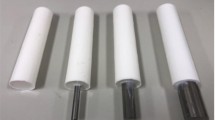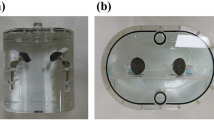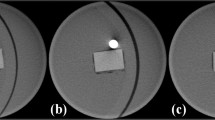Abstract
The aim of our study is to evaluate the metal artefact reduction techniques with the same contrast scale for different vendors’ dual-energy CT (DECT): kV-CT image with metal artefact reduction method and monoenergetic CT image using Canon’s DECT, and monoenergetic CT image with metal artefact reduction method using GE’s DECT. The kV-CT image and DECT scans were performed with the water-based polymethyl methacrylate phantom with various metal materials (brass, aluminium, copper, stainless steel, steel, lead, and titanium). Two types of metal artefact reduction (MAR) algorithm with the monoenergetic CT images were used. Smart MAR implemented by GE and the kV-CT images with MAR algorithms. Single-energy metal artefact reduction (SEMAR), implemented by Canon, was reconstructed. The artefact index was evaluated using the converted electron density values from the kV-CT and DECT images. The artefact index with all material inserts in the monoenergetic CT images were smallest at 70–90 keV for Canon and 140 keV for GE. The artefact index without SEMAR was larger than that with SEMAR for the 80 and 135-kV CT images. In the comparison of the artefact index for the converted electron density images from the 80 and 135-kV CT images with SEMAR, as well as the monoenergetic CT images with and without MAR, the monoenergetic CT image at 140 keV with MAR showed a reduction. In the comparison of the monoenergetic CT images at 140 keV and other energy ranges without and with Smart MAR, there was no statistically significant difference (P < 0.05) for all-metal inserts at more than 100 keV for Canon’s DECT and 70 keV for GE’s DECT. The metal artefact could be reduced by using a monoenergetic CT image at high energy with MAR algorithm. The metal artefact for the different-contrast-scale images can be compared on the same contrast scale by the electron density conversion method.






Similar content being viewed by others
References
Barrett JF, Keat N (2004) Artifacts in CT: recognition and avoidance. RadioGraphics 24:1679–1691
Fleischmann D, Boas FE (2011) Computed tomography - old ideas and new technology. Eur Radiol 21:510–517
Wu X, Langan DA, Xu D et al (2009) Monochromatic CT image representation via fast switching dual kVp. Proc SPIE 7258:725845
Meinel FG, Bischoff B, Zhang Q, Bamberg F, Reiser MF, Johnson TR (2012) Metal artifact reduction by dual-energy computed tomography using energetic extrapolation: a systematically optimized protocol. Investig Radiol 47:406–414
Bamberg F, Dierks A, Nikolaou K et al (2011) Metal artifact reduction by dual energy computed tomography using monoenergetic extrapolation. Eur Radiol 21(7):1424–1429
Goodsitt MM, Emmanuel G, Larson SC (2011) Accuracies of the synthesized monochromatic CT numbers and effective atomic numbers obtained with a rapid kVp switching dual energy CT scanner. Med Phys 38(4):2222–2232
Chandra N, Langan DA (2011) Gemstone detector: dual energy imaging via fast kVp switching. In: Johnson TRC, Fink C, Schönberg SO, Reiser MF (eds) Dual energy CT in clinical practice. Springer-Verlag, Berlin, pp 35–41
Lee YH, Park KK, Song HT et al (2012) Metal artifact reduction in gemstone spectral imaging dual-energy CT with and without metal artifact reduction software. Eur Radiol 22(6):1331–1340
Kawahara D, Ozawa S, Yokomachi K et al (2018) Evaluation of a metal artifact reduction techniques by electron density for single energy CT and dual energy CT. BJR Open. https://doi.org/10.1259/bjro.20180045
Giantsoudi D, De Man B, Verburg J et al (2017) Metal artifacts in computed tomography for radiation therapy planning: dosimetric effects and impact of metal artifact reduction. Phys Med Biol 62(8):R49–R80
Schneider CA, Rasband WS, Eliceiri KW (2012) NIH Image to ImageJ: 25 years of image analysis. Nat Methods 9(7):671–675
Yi Hu, Pan S, Zhao X et al (2017) Value and Clinical Application of Orthopedic Metal Artifact Reduction Algorithm in CT Scans after Orthopedic Metal Implantation. Korean J Radiol 3:526–535
Cha J, Kim HJ, Kim ST et al (2017) Dual-energy CT with virtual monochromatic images and metal artifact reduction software for reducing metallic dental artifacts. Acta Radiol 58(11):1312–1319
Toepker M, Czerny C, Ringl H et al (2014) Can dual-energy CT improve the assessment of tumor margins in oral cancer? Oral Oncol 50:221–227
Das IJ, Cheng CW, Cao M et al (2017) Dual-energy CT with virtual monochromatic images and metal artifact reduction software for reducing metallic dental artifacts. Acta Radiol 58(11):1312–1319
Huang JY, Kerns JR, Nute JL et al (2015) An evaluation of three commercially available metal artifact reduction methods for CT imaging. Phys Med Biol 60(3):1047–1067
Author information
Authors and Affiliations
Corresponding author
Ethics declarations
Conflict of interest
The authors have no relevant conflicts of interest to disclose.
Additional information
Publisher's Note
Springer Nature remains neutral with regard to jurisdictional claims in published maps and institutional affiliations.
Rights and permissions
About this article
Cite this article
Kawahara, D., Ozawa, S., Yokomachi, K. et al. Evaluation of metal artefact techniques with same contrast scale for different commercially available dual-energy computed tomography scanners. Phys Eng Sci Med 43, 539–546 (2020). https://doi.org/10.1007/s13246-020-00854-7
Received:
Accepted:
Published:
Issue Date:
DOI: https://doi.org/10.1007/s13246-020-00854-7




